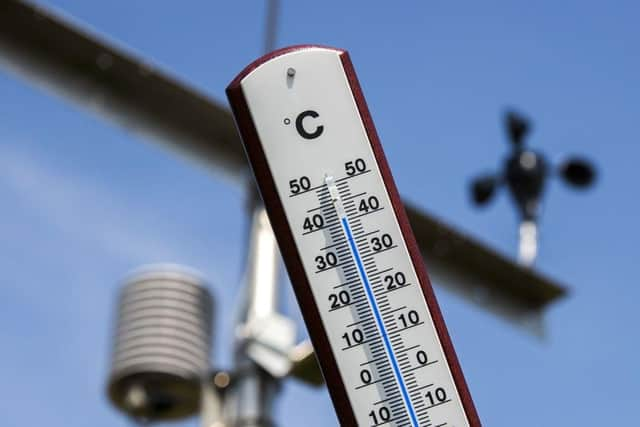Heatwave UK: Met Office weather forecast as level 4 red warning issued - how long will hot temperatures last?
and live on Freeview channel 276
The Met Office has warned of a possibility that temperatures in Britain may reach 40°C by mid-July.
This isn’t necessarily going to happen, but the prediction is significant nonetheless - and, according to the Met Office, the likelihood of the UK reaching 40°C temperatures has increased since their initial predictions earlier in the month.
Advertisement
Hide AdAdvertisement
Hide AdEven if temperatures don’t reach 40°C, they’re still likely to exceed previous record heights, and the Met Office has issued its first ever level four Red Alert warning.
Here’s everything you need to know about predicted 40°C temperatures.
Will UK temperatures reach 40°C this July?


It’s looking increasingly likely, with the Met Office issuing a statement on Friday 15 July warning that “there is a 50% chance we could see temperatures top 40°C and 80% we will see a new maximum temperature reached”.
The way the Met Office issues weather predictions is with something called an ensemble forecast – a number of computers each run a predictive model, between them calculating each different potential weather outcome. The number of times the computers suggest a certain result is indicative of the likelihood of that weather pattern. For example, if a plurality of computers suggest rain (each computer having analysed a different chain of events that could lean to rain), the Met Office would interpret that to mean rain is the most likely weather.
Advertisement
Hide AdAdvertisement
Hide AdInitially, only a minority of computers in the Met Office’s ensemble forecast suggested that the UK might reach 40°C temperatures this July. That would mean it’s a possibility, but far from certain. However, the Met Office has since revised its predictions, with new models from the ensemble forecast increasingly starting to suggest higher temperatures.
Even if we don’t reach 40°C temperatures this July, the essentially unprecedented forecast is still indicative of wider (and dangerous) trends linked to global warming. Matthew Killick, Director of Crisis Response and Community Resilience at the British Red Cross, noted that “in England alone there were more than 2,500 excess deaths in the summer of 2020, and unfortunately it’s predicted that heat-related deaths in the UK could treble within 30 years.”
What would it take for UK temperatures to reach 40°C this July?
The risk of 40°C temperatures in the UK is particularly high at the moment – the highest it has ever been. While there are a number of different events that would have to happen for the UK to reach 40°C, it’s looking increasingly likley that those factors will align as necessary.
For the UK to reach 40°C in July, the warmest air from Africa would need to move through Spain and France to the UK. This would depend on low air pressure in and around Iberia.
Advertisement
Hide AdAdvertisement
Hide AdThis is also closely linked to global warming, as climate attribution scientist at the Met Office Dr Nikos Christidis explained. “Climate change has already influenced the likelihood of temperature extremes in the UK. The chances of seeing 40°C days in the UK could be as much as 10 times more likely in the current climate than under a natural climate unaffected by human influence.”
“The likelihood of exceeding 40°C anywhere in the UK in a given year has also been rapidly increasing,” continued Dr Christidis. “Even with current pledges on emissions reductions, such extremes could be taking place every 15 years in the climate of 2100.”
The Met Office initially warned of is a “30% risk” of a new record temperature being set, but has since revised that prediction to suggest that “there is a 50% chance we could see temperatures top 40°C and 80% we will see a new maximum temperature reached”.
The current record is 38.7°C in July 2019.
How long will the current heatwave last? When will it end?
As ever, it’s difficult to say when the UK heatwave will end. In a statement, the Met Office have suggested that temperatures will peak on the 17th and 18th, and then begin to cool down in the latter half of that week.
Advertisement
Hide AdAdvertisement
Hide AdMet Office Deputy Chief Meteorologist Rebekah Sherwin explained that “from Sunday and into Monday, temperatures are likely to be in excess of 35°C in the southeast, although the details still remain uncertain. Elsewhere, temperatures could be fairly widely above 32°C in England and Wales, and in the mid-to-high 20s Celsius further north.”
When the Met Office issued their Red Warning, they suggested that after Tuesday 18 July, “temperatures are expected to start to return closer to normal for the time of year from the middle of next week onwards as cooler air pushes across the country from the west.”
What is the Heat Health Alert currently?
The Heat Health Alert has been raised to level 4 (the first ever Red Warning to be issued in response to heat) in central, northern, eastern and southeastern England. The existing level 3 alert has been expanded to include Cornwall, west Wales and parts of southern Scotland, as illustrated on the map below.
There are four levels to the Heat Health Alert. Level 3 is an Amber Alert, which is issued when the Heat Health Alert thresholds have been exceeded (between 28°C and 32°C depending on the area of the country). Level 4 is a Red Alert, meaning “a heatwave is so severe and/or prolonged that its effects extend outside the health and social care system. At this level, illness and death may occur among the fit and healthy, and not just in high-risk groups.”
Advertisement
Hide AdAdvertisement
Hide AdThe alert prompts social and healthcare groups to take preparatory action to be better able to respond to risks faced.
Mayor of London Sadiq Khan has also activated the capital’s Severe Weather Emergency Protocols (SWEP), typically only activated in the winter during dangerous sub-zero temperatures.
Is it dangerous? What precautions should I take?
It is, yes. Heatwaves are always dangerous to vulnerable groups - like the elderly or very young children - but Red and Amber Alert Warnings means the weather can impact non-vulnerable groups as well.
Per the Met Office, an Amber Alert Warning “highlights likely adverse health effects for the public, not just limited to those most vulnerable to extreme heat”, while a Red Alert means “a heatwave is so severe and/or prolonged that its effects extend outside the health and social care system. At this level, illness and death may occur among the fit and healthy, and not just in high-risk groups.”
Advertisement
Hide AdAdvertisement
Hide AdPeople should take steps to avoid dehydration by drinking lots of water, wear suncream to prevent sunburn, and be concious of the risks associated with heatstroke and how to spot it. There are a number of steps you can take personally to keep cool, and to keep cats and dogs cool too.
Mayor of London Sadiq Khan has advised local London authorities to “[take] action to assist those forced to sleep rough in these extremely high temperatures, by increasing welfare checks, providing plenty of water and sunscreen, and ensuring people sleeping rough know where to access cool spaces and water fountains”.
This response is part of the Severe Weather Emergency Protocols (SWEP), typically only activated in the winter during dangerous sub-zero temperatures.
What was the previous hottest day in Britain?


If the UK were to reach 40°C this July, that would be the warmest temperature recorded in the UK.
Advertisement
Hide AdAdvertisement
Hide AdCurrently, the warmest day on record in the UK is 25 July 2019, when the Cambridge Botanic Garden reached 38.7°C.
Prior to that, the highest temperature in the UK was 38.5°C, recorded in Kent in August 2003.
Two of the top five highest temperatures in the UK were recorded in Heathrow, with 37.8°C in July 2020 and 36.7°C in July 2015.
Outside of England, the warmest temperature recorded in Wales was 35.2°C on 2 August 1990, 32.9°C in Scotland on 9 August 2003, and 31.3°C in Northern Ireland on 21 July 2021.
Is it likely that Britain might reach 40°C temperatures in future?
Advertisement
Hide AdAdvertisement
Hide AdIt’s certainly plausible, and indeed quite likely. Recent research has suggested that, even if Britain doesn’t reach 40°C this year, with every passing summer that risk increases.
In a statement, the Met Office said that “the increase in the frequency, duration, and intensity of these [extreme heat events] over recent decades is clearly linked to the observed warming of the planet and can be attributed to human activity. ”
Dr Mark McCarthy, the head of the Met Office National Climate Information Centre, said that “there is already a strongly-embedded warming due to climate change across the continent that is increasing the likelihood of challenging the existing UK temperature record.”
Climate attribution scientist at the Met Office, Dr Nikos Christidis, said “in a recent study we found that the likelihood of extremely hot days in the UK has been increasing and will continue to do so during the course of the century, with the most extreme temperatures expected to be observed in the southeast of England.”
Advertisement
Hide AdAdvertisement
Hide Ad“The likelihood of exceeding 40°C anywhere in the UK in a given year has also been rapidly increasing, and, even with current pledges on emissions reductions, such extremes could be taking place every 15 years in the climate of 2100.”
Comment Guidelines
National World encourages reader discussion on our stories. User feedback, insights and back-and-forth exchanges add a rich layer of context to reporting. Please review our Community Guidelines before commenting.
